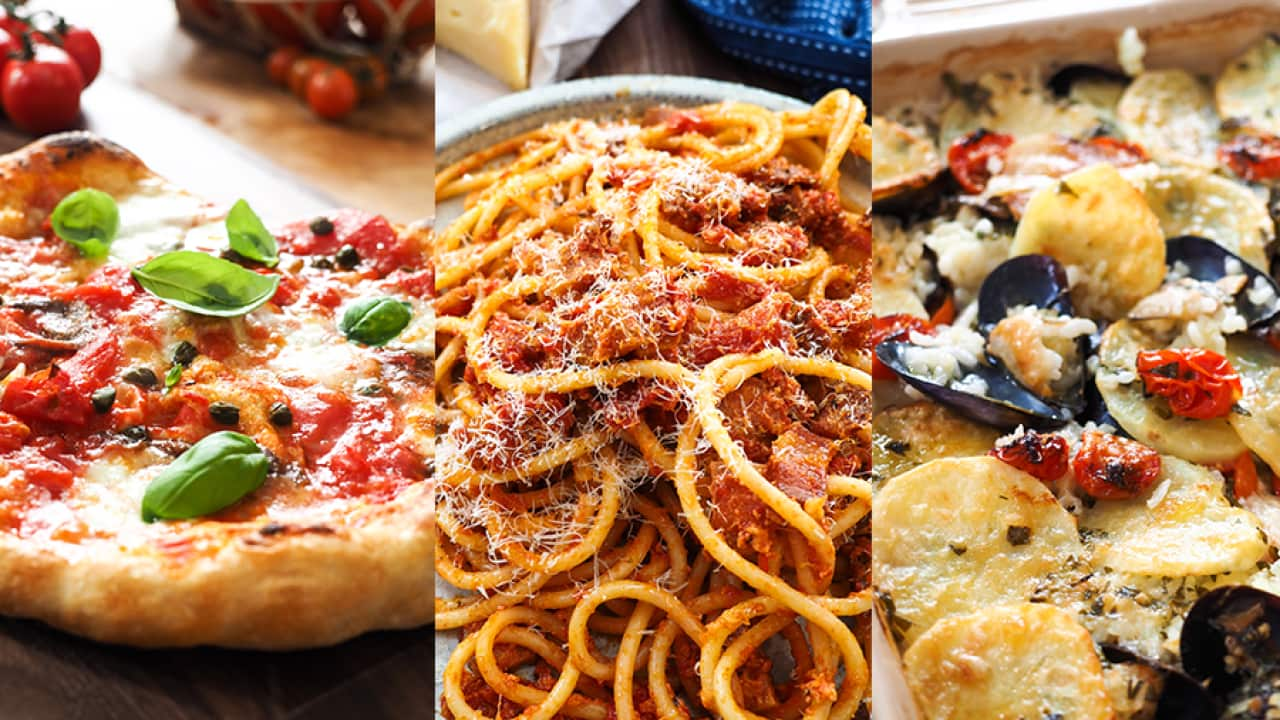'Italian food' is really a massive umbrella shielding the country's highly-localised cuisines. The real discovery comes from finding out which dishes hail from where, and what they were born out of – be it poverty or triumph. However, there are three special dishes to look out for, which are among Italy’s national treasures.
Pasta all'Amatriciana
Host of Cook Like an Italian, Silvia Collaca, adores pasta all'Amatriciana, a famous recipe that can be traced back over a thousand years to the small town of Amatrice.
"Some Italian recipes are so representative of our culture that the Italian government enshrined them to ‘Traditional Food of Italy’ status, which is like the hall of fame for Italian food,” she says. Amatriciana has indeed made the prestigious ranks. According to the Amatrice mayor’s office, Amatriciana sauce is traditionally made with six ingredients: guanciale (cured meat from pork jowl), white wine, San Marzano tomatoes, pecorino cheese, pepper and chilli.
According to the Amatrice mayor’s office, Amatriciana sauce is traditionally made with six ingredients: guanciale (cured meat from pork jowl), white wine, San Marzano tomatoes, pecorino cheese, pepper and chilli.

Guanciale is less salty than pancetta, creating a balanced dish. Source: Cook like an Italian
Collaca references the guanciale as a "make or break ingredient". The cured pork jowl is a little harder to track down in Australia but can be found at most good Italian delis. It’s not as salty as cousin pancetta; an important inclusion to maintain balance in the dish.
Some Italian recipes are so representative of our culture that the Italian government enshrined them to ‘Traditional Food of Italy’ status
Apulian mussel and potato stew
"Rice dishes don’t feature much in southern Italian cooking, simply because rice doesn’t grow there," says Collaca. “This dish is a notable exception.”
This ancient stew hails from Puglia, otherwise known as ‘the heel of Italy’. The “tiella” as it’s called in Italian, is a casserole combining fresh mussels (still in their shell), tomato, potatoes and rice. As with all Italian bakes, this dish is built from the bottom up, starting with sliced shallots, oil and thinly sliced potatoes. The Pugliese can be particular about the name of the stew, typically titling it ‘patata, riso, cozze’ – in that order of hierarchy, with potato first. Northern Italians will sometimes call it 'riso, patata, cozze', due to a broad love for rice.
The Pugliese can be particular about the name of the stew, typically titling it ‘patata, riso, cozze’ – in that order of hierarchy, with potato first. Northern Italians will sometimes call it 'riso, patata, cozze', due to a broad love for rice.

The rice falls into the open mussels and soaks up so much flavour. Source: Cook like an Italian
After the potatoes, mussels and tomato are combined, rice is generously sprinkled on top to finish the dish; then placed in the oven. “The rice falls into the open shells and so as it bakes it swells up and absorbs all the beautiful mussel juices, the tomatoes, the olive oil, and becomes just a wondrous, wondrous thing,” Colloca says.
Pizza Napoletana
Back in 2017, two million Italians signed a petition to protect Neapolitan pizza with UN World Heritage status. The recipe is even protected by the European Union.
"Let me tell you something, pizza Napoletana done the right way – the traditional way – is actually good for you," says Collaca, and we believe her. By the right way, she means the way the Associazione Verace Pizza Napoletana (the True Neapolitan Pizza Association) deems right. We thought we'd ask a literal champion on how to make it – Andrea Cozzolino, the 2016 World Pizza Champion. Cozzolino beat over 600 other pizzaiolos from around the world with his pizza Napoletana, when he was just 25 years old.
By the right way, she means the way the Associazione Verace Pizza Napoletana (the True Neapolitan Pizza Association) deems right. We thought we'd ask a literal champion on how to make it – Andrea Cozzolino, the 2016 World Pizza Champion. Cozzolino beat over 600 other pizzaiolos from around the world with his pizza Napoletana, when he was just 25 years old.

Silvia Colloca's very not-certified frying pan pizza Napoletana. Source: Cook like an Italian
How does he make the ultimate pizza Napoletana? "The dough must be low to medium strength in protein. You allow the dough to rise and ferment for a minimum of eight hours, then keep it at room temperature for 24 hours,” Cozzolino says.
Allowing the dough to rise multiple times provides more air and makes it easier to digest.
“Divide the dough into 250gm balls then allow it to rise again for four hours. Allowing the dough to rise multiple times provides more air and makes it easier to digest.
"Stretch the dough to remove all the from the centre of the dough to the edge, this is what forms your nice and fluffy crust. Spread San Marzano tomato and mozzarella around the base of the pizza, leaving 1cm from the edge bare. Add basil and olive oil, cook in a woodfire oven between 60 to 90 seconds at 480°C and enjoy!"
Cozzolino has since moved on from his time as an accredited Neapolitan pizza master to tackle a new challenge. The pizzaolo can now be found at developing gluten-free pizza bases for the wholesale market.
NATIONAL TREASURES AT HOME

Apulian potato, mussels and rice bake (Apulian tiella)
Find Silvia Colloca sharing family secrets from her very own kitchen in the brand-new series Cook Like an Italian, Wednesdays at 8:30pm on SBS Food from 8 January to 11 March 2020 and later on . Head to for recipes, articles, tips and more. Follow the 'like an Italian' series .









